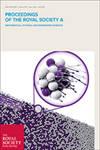超大溶质原子对间隙团簇扩散的限制
Proceedings of the Royal Society of London. Series A. Mathematical and Physical Sciences
Pub Date : 2004-09-08
DOI:10.1098/rspa.2004.1289
引用次数: 26
摘要
研究了超大溶质原子对高能辐照金属中自间隙原子团簇扩散的影响。我们使用动力学蒙特卡罗(KMC)模拟模型体心立方铁,并包括缺陷之间的弹性相互作用。我们证明溶质原子和团簇之间的弹性排斥可以将后者限制在一维段。假设每个簇的简单运动方向不经常旋转,允许它逃逸到一个新的受限段。通过KMC模拟和解析理论探讨了约束对团簇的有效扩散率及其与其他小静态球形汇的反应速率的影响。结果表明,理论预测结果与计算机模拟结果吻合较好。我们提出了这些发现对设计更能抵抗高能辐射损伤影响的合金的一些可能的后果。本文章由计算机程序翻译,如有差异,请以英文原文为准。
Confinement of interstitial cluster diffusion by oversized solute atoms
We study the effects of oversized solute atoms on the diffusion of clusters of self–interstitial atoms produced in metals by high–energy irradiation. We use kinetic Monte Carlo (KMC) simulations in model body–centred cubic iron, and include elastic interactions between the defects. We show that elastic repulsion between solute atoms and the clusters can confine the latter to one–dimensional segments. The easy direction of motion of each cluster is assumed to rotate infrequently, allowing it to escape to a new confined segment. The consequences of the confinement for the effective diffusivity of the cluster and its rate of reaction with other small static spherical sinks are explored both by KMC simulations and by an analytic theory. It is shown that the predictions of the theory agree very well with the computer simulations. We suggest some of the possible consequences of these findings for the design of alloys that are more resistant to the effects of high–energy radiation damage.
求助全文
通过发布文献求助,成功后即可免费获取论文全文。
去求助
来源期刊
自引率
0.00%
发文量
0
期刊介绍:
Proceedings A publishes articles across the chemical, computational, Earth, engineering, mathematical, and physical sciences. The articles published are high-quality, original, fundamental articles of interest to a wide range of scientists, and often have long citation half-lives. As well as established disciplines, we encourage emerging and interdisciplinary areas.

 求助内容:
求助内容: 应助结果提醒方式:
应助结果提醒方式:


